Key takeaways:
- Green investing prioritizes environmental sustainability and aligns financial gains with positive ecological impacts.
- Understanding ESG scores is crucial for evaluating the sustainability practices of companies, which can lead to both financial returns and social benefits.
- Common misconceptions include the belief that green investments yield lower returns or are only for the wealthy; small investments can also make a meaningful impact.
- Patience and thorough research are essential for success in green investing, as it is a long-term commitment rather than a short-term trend.
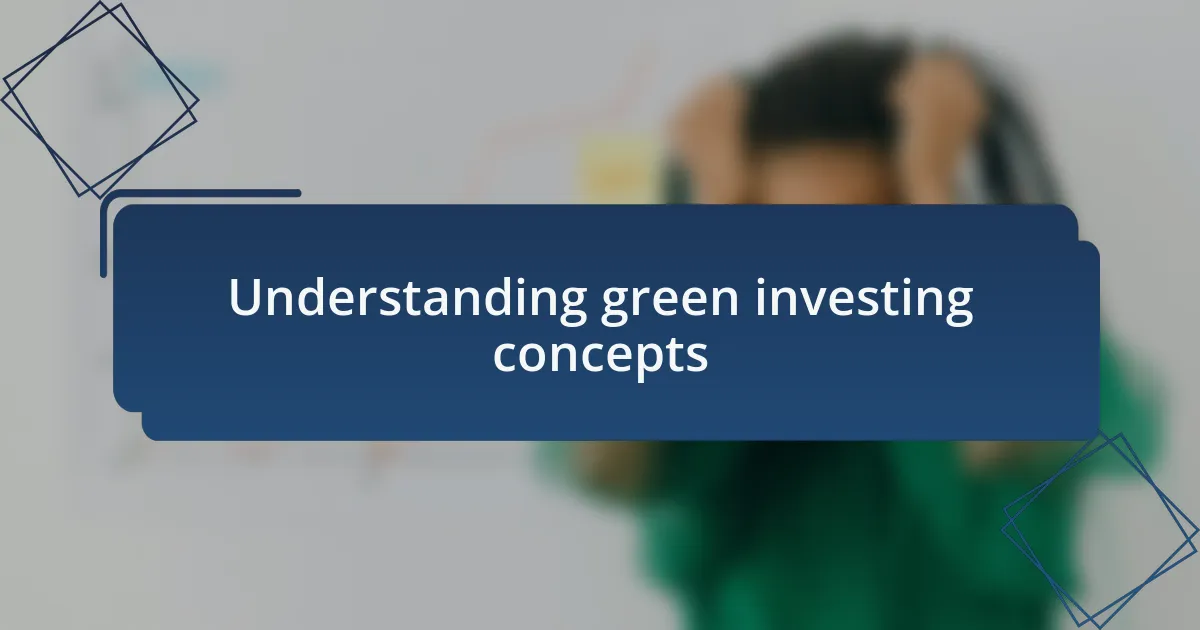
Understanding green investing concepts
Green investing focuses on directing funds towards companies and projects that prioritize environmental sustainability. It’s about more than just supporting eco-friendly initiatives; it’s a commitment to aligning financial gains with positive environmental impacts. I remember my initial confusion when I started exploring this concept. What exactly made an investment “green”? I realized it often hinged on criteria like renewable energy production, waste reduction, and sustainable resource management.
As I delved deeper, I discovered that green investments can manifest in various forms, including green bonds, which are used to fund projects aiming to address climate change. This struck a chord with me; the idea that I could finance something as significant as solar energy installations felt empowering. Has anyone else felt that rush of excitement when realizing the potential of their money to make a difference?
Furthermore, understanding the impact metrics is crucial in green investing. For instance, the effectiveness of a company’s sustainability practices can often be measured through Environmental, Social, and Governance (ESG) scores. These scores helped me make informed decisions about where to place my finances. It was eye-opening to recognize that investing with a green lens could lead not only to financial returns but also contribute positively to society.
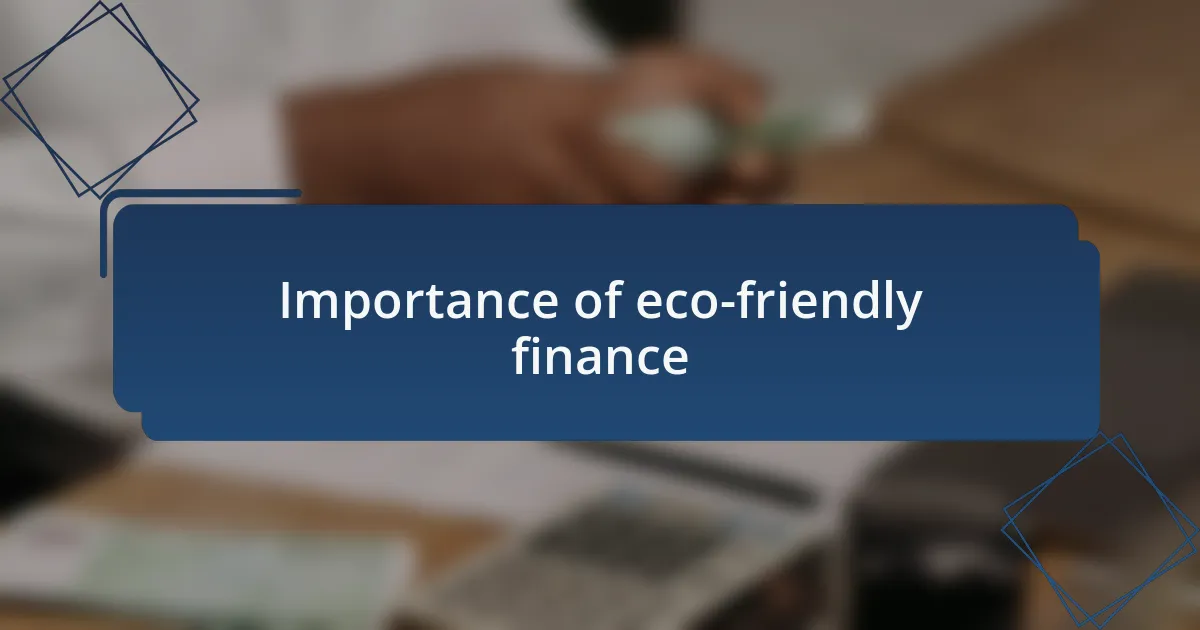
Importance of eco-friendly finance
The importance of eco-friendly finance can’t be overstated. It represents a significant shift in how we view investments, merging personal finance with broader environmental goals. For me, the realization that my financial choices could either harm or help the planet was profound. Have you ever thought about how your money flows? It’s fascinating to consider that every dollar could either support a factory pumping out pollutants or a renewable energy project that aims to reduce our carbon footprint.
Moreover, investing with an eco-conscious approach can also align with long-term financial stability. Companies that focus on sustainability are often more resilient in the face of regulatory changes or shifts in consumer preferences. I’ve witnessed businesses that prioritize eco-friendly practices not only thrive but also garner loyal customer bases. This made me reflect: why wouldn’t I want to be part of something that is not only financially beneficial but also ethically sound?
Ultimately, eco-friendly finance has the power to drive systemic change. By reallocating funds to support green initiatives, we collectively shape a future that values sustainability over short-term gains. I think back on my own journey when I chose to invest in green technology companies; that decision felt like planting a seed for a healthier planet. Isn’t it inspiring to know that we can promote positive change simply through our investment choices?
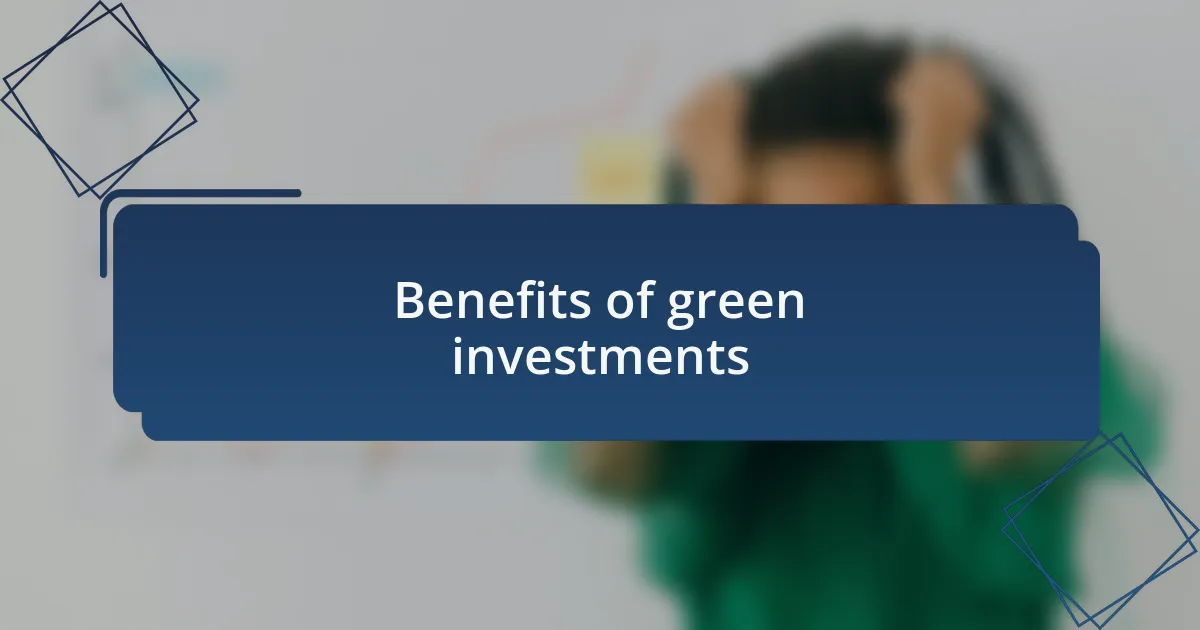
Benefits of green investments
Green investments come with a multitude of benefits that can be quite rewarding. For instance, I’ve noticed that many sustainable companies not only show solid financial returns but also often outperform their conventional counterparts over time. Isn’t it comforting to know that your financial growth can coincide with a healthier planet?
Another key advantage I’ve experienced is the pride that comes with contributing to positive change. When I invested in a renewable energy project, I felt a sense of purpose knowing my money was helping to combat climate change. How often do we get to say our investments are making a real difference? It truly reshapes the way we think about our financial decisions.
Additionally, green investments can have a positive influence on risk management. Companies embracing sustainability tend to be forward-thinking and adaptable, which, in my view, makes them less vulnerable to environmental regulations and economic upheavals. Reflecting on my own portfolio, I’ve found that the green initiatives I support bring an extra layer of security that feels reassuring amidst market uncertainties. Don’t you think it’s wise to invest in firms that are proactively addressing future challenges?
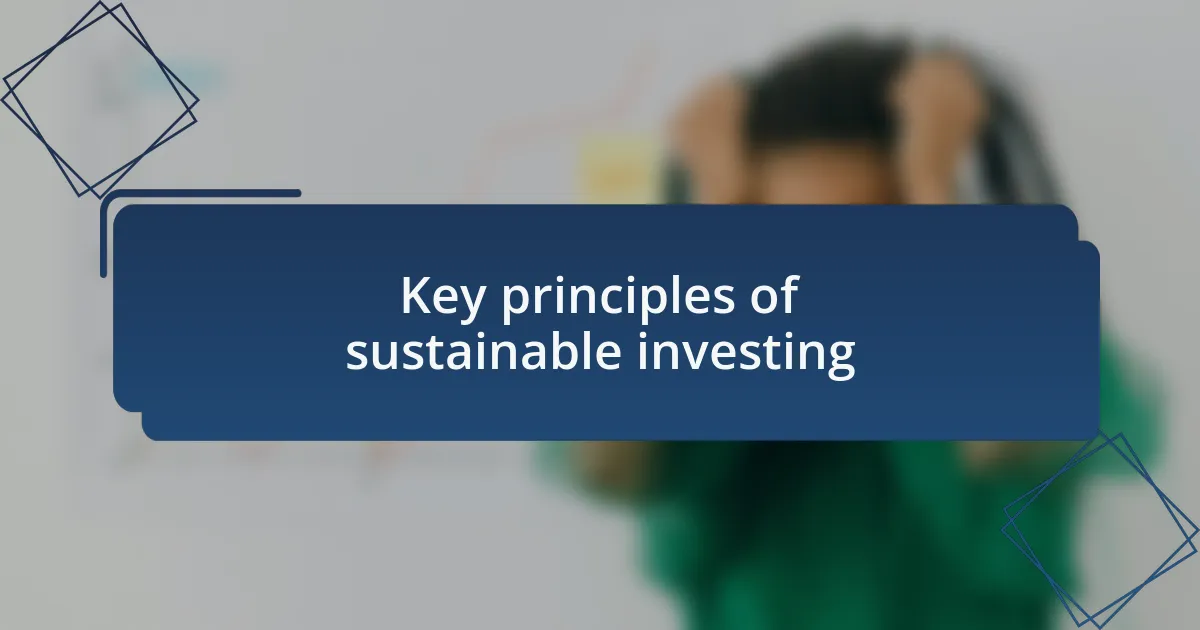
Key principles of sustainable investing
Investing sustainably isn’t solely about the financial return; it’s about aligning your values with your investment choices. I recall when I first began my journey into green investing, the principle of environmental, social, and governance (ESG) criteria stood out to me. This threefold approach allows investors like myself to evaluate companies not just on profitability, but also on their impact on society and the planet. How often do we consider the broader implications of our financial choices?
Another foundational principle is transparency. In my experience, sustainable companies tend to be more open about their practices and performance. I remember looking into a green tech firm where their annual reports included details on both their carbon footprint and community initiatives. This level of honesty sparked my confidence in their commitment. Shouldn’t we hold our investments to the same standards we expect in our everyday lives?
Furthermore, I learned the importance of diversification within sustainable investing. Investing across various sectors—like renewable energy, sustainable agriculture, and eco-friendly consumer products—has provided me with both stability and growth. I’ve found that a well-rounded portfolio not only mitigates risk but also allows for a deeper engagement with diverse industries, amplifying the positive impact of my investments. Isn’t it empowering to know you’re contributing to multiple facets of sustainability with your financial choices?
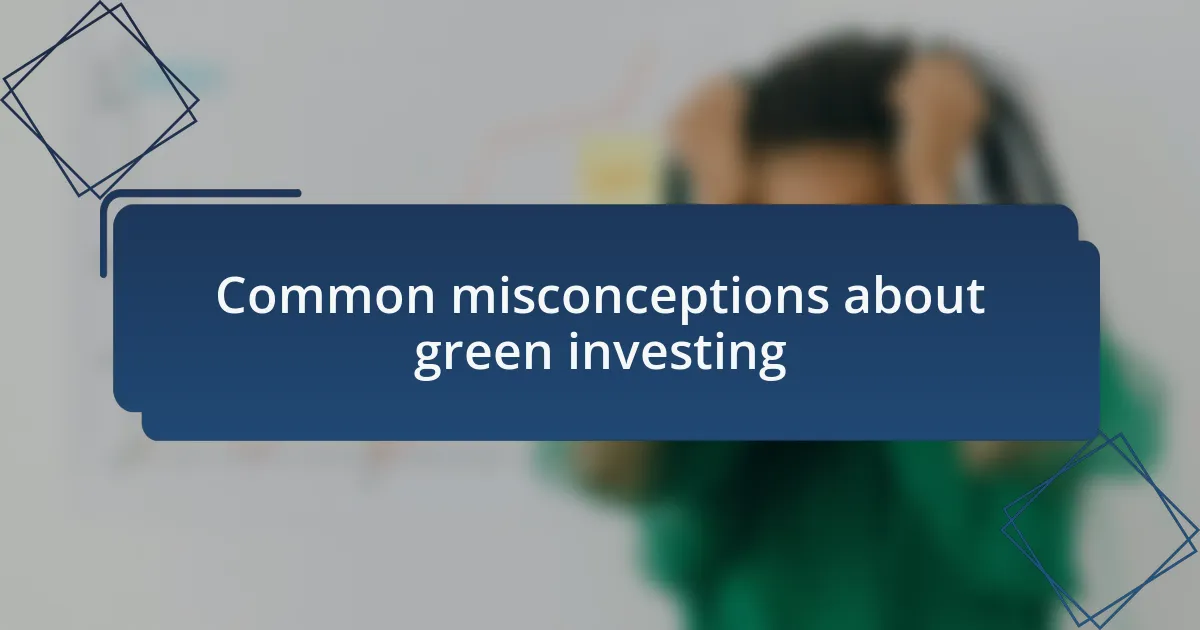
Common misconceptions about green investing
One common misconception I encountered early in my green investing journey is the belief that such investments always yield lower financial returns. When I first dipped my toes into this realm, I worried that aligning my portfolio with my values meant making significant sacrifices on performance. However, I soon discovered that many sustainable companies outperform traditional investments over the long term. Can you imagine the power of investing in businesses that not only generate profit but also cultivate a better world?
Another misunderstanding is that green investing is only for the wealthy or those with considerable resources. I used to think that I needed a hefty sum to make a meaningful impact. Yet, I’ve realized that even small investments can contribute to sustainable ventures. I started with modest contributions to environmentally conscious funds, and it felt amazing to watch even limited resources grow while supporting causes I care about. Isn’t it inspiring to know that everyone can participate, regardless of their financial situation?
Some may also believe that green investments require excessive research and knowledge, making them intimidating. In my experience, while it’s true that understanding the nuances of sustainability takes time, there are countless resources and communities ready to help newcomers. I remember feeling overwhelmed at first, but joining online forums and connecting with like-minded individuals made the learning process enjoyable. Why let fear of the unknown hold you back from investing in a future you believe in?
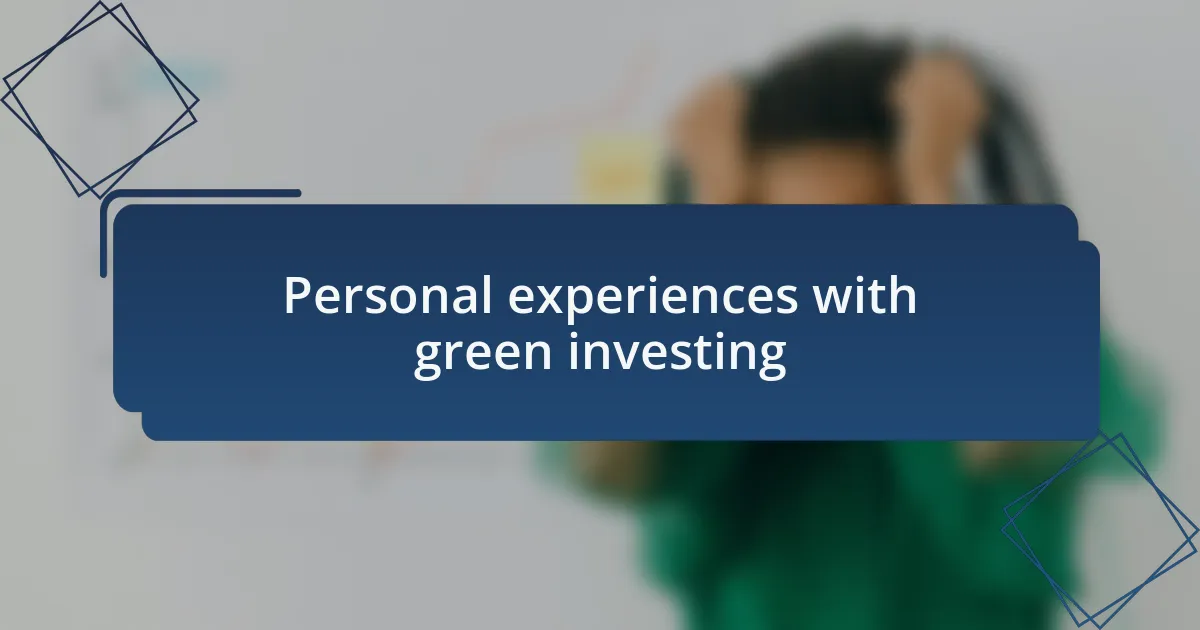
Personal experiences with green investing
When I first started my green investing journey, I vividly remember the sense of apprehension I felt. I worried about whether I would miss out on better opportunities. However, as I began to research and invest in renewable energy projects, I was struck by a wave of excitement—realizing I was part of something bigger than myself. This experience taught me that aligning my investments with my values can lead to both personal satisfaction and potential financial growth.
I also recall the countless discussions I had with friends who were skeptical about green investing. They often asked me if I felt my investments were too risky. I shared my experiences with succcessful companies in the clean tech sector that have consistently delivered impressive returns. Seeing their skepticism shift to curiosity felt incredibly rewarding, as I realized I could inspire others to join this journey, creating a ripple effect of positive change.
One pivotal moment for me was attending a green investment seminar. It was enlightening to hear industry experts speak about tangible outcomes from sustainable investments. I remember thinking, “This is not just idealism; it’s practicality!” This realization empowered me and reaffirmed that green investing is a real, effective way to contribute to environmental betterment while still pursuing financial goals. Don’t you think it’s amazing how knowledge can transform perceptions?
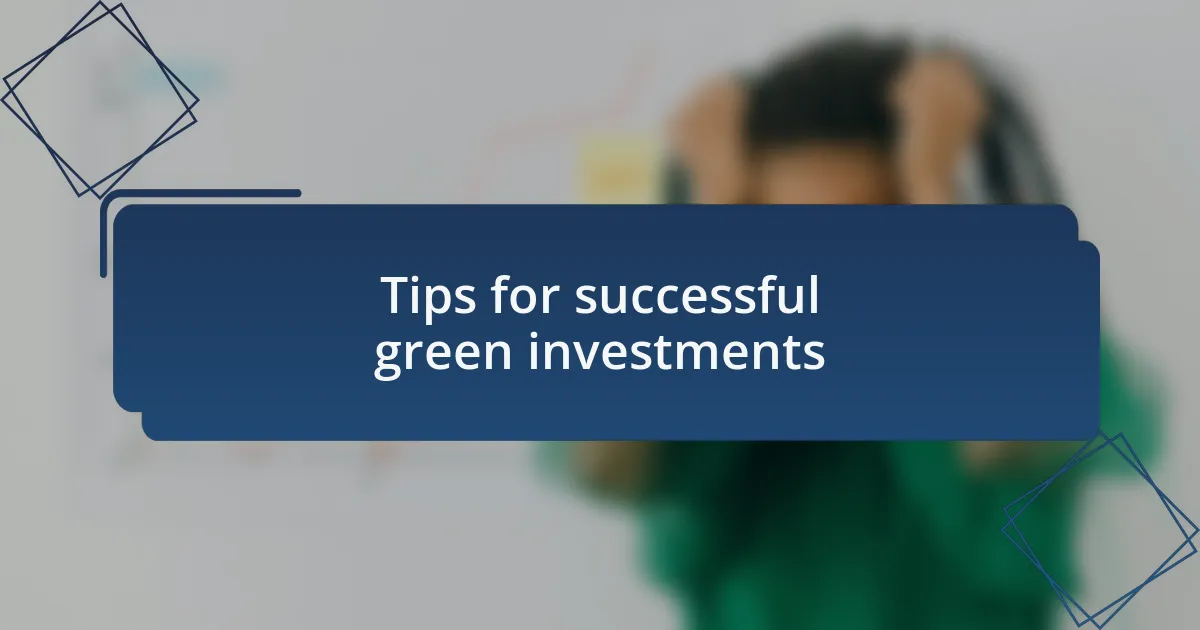
Tips for successful green investments
When I first dived into green investing, I quickly learned the power of due diligence. It’s not enough to want to invest in something eco-friendly; I realized I had to research the companies thoroughly. I remember finding a small solar start-up that seemed promising. After digging deeper, I discovered inconsistencies in their financials. This taught me that passion must be anchored in solid information—what do you look for when evaluating a potential investment?
I also found that networking with fellow green investors can yield invaluable insights. One evening at a sustainability-focused event, I chatted with someone who shared their experience with a successful wind energy project. Their enthusiasm was infectious, and the next day, I felt motivated to explore similar projects. Sharing stories and experiences can not only boost confidence but also enhance our understanding of market dynamics—have you ever thought about how much we can learn from each other?
Lastly, my experience has shown me the importance of patience in green investing. I recall feeling impatient when the market for electric vehicles initially seemed slow to grow. However, sticking with my investments paid off as the landscape transformed. This journey taught me that green investing is not just a trend; it’s a long-term commitment. Are you prepared to ride the waves of this evolving market?